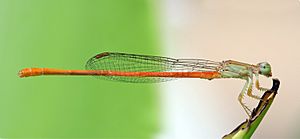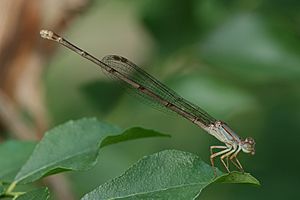Ceriagrion glabrum facts for kids
Quick facts for kids Ceriagrion glabrum |
|
|---|---|
 |
|
| Adult male | |
| Conservation status | |
| Scientific classification |
The Ceriagrion glabrum is a type of damselfly. It belongs to the family Coenagrionidae. People call it by many names, like common orange or common waxtail. You can find this damselfly all over Africa. It usually lives in places with lots of reeds.
What Does It Look Like?
This damselfly is small to medium-sized. It can grow up to 46 millimeters (about 1.8 inches) long. Its wings can spread up to 53 millimeters (about 2.1 inches) wide. Its eyes are a greenish color with a dark grey top.
Male and female damselflies look quite different. This is called sexual dimorphism. Male Ceriagrion glabrum damselflies are bright orange. Their bodies and chests have no marks. The sides of their bodies are a lighter yellow-orange.
Female damselflies can be brown, green, or orange. As they get older, they become more orange. But they never get as bright as the males.
Where Do They Live?
This damselfly is the most common Ceriagrion species in Africa. It lives in many countries. These include South Africa, Kenya, Nigeria, and Egypt. It is found in almost all parts of Africa.
You can find these damselflies in many freshwater places. This includes marshes, ponds, and dams. They also live in quiet parts of rivers and streams. They like areas with lots of reeds, grasses, and sedges.
How Do They Live?
Ceriagrion glabrum damselflies like to sit on plant stems. They choose reeds, grasses, and sedges. They usually perch low, close to the water. These damselflies can only fly short distances. Their flight is not very strong.
Even though they are often near water, you can sometimes find them far away. These damselflies can be fierce hunters. They sometimes eat other, smaller damselflies. This happens especially when the smaller ones are young and soft.
How Are They Protected?
The IUCN lists this species as "least concern." This means it is not currently in danger. The damselfly can adapt well to different places. It can live in man-made habitats, like dams.



